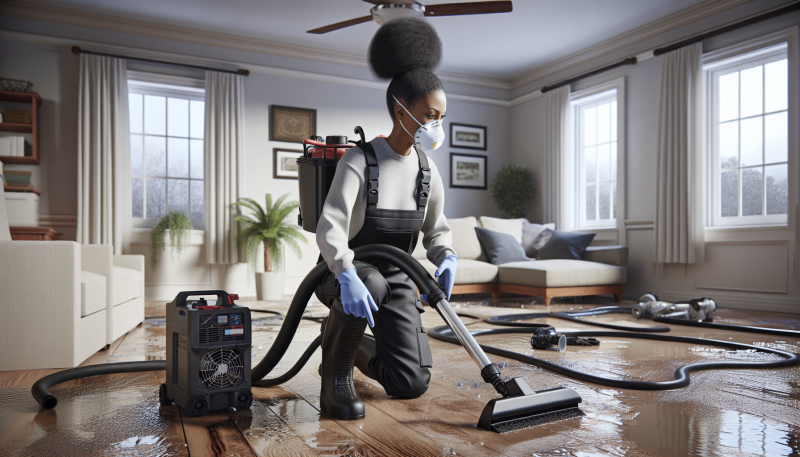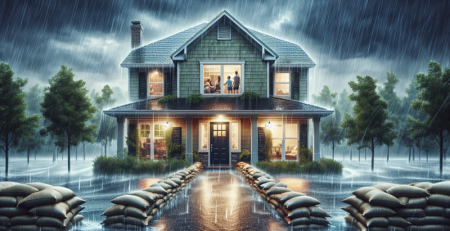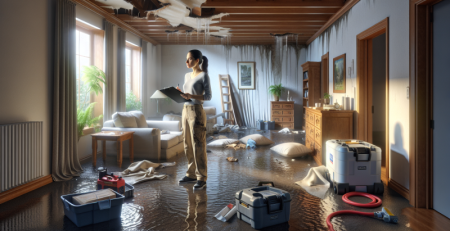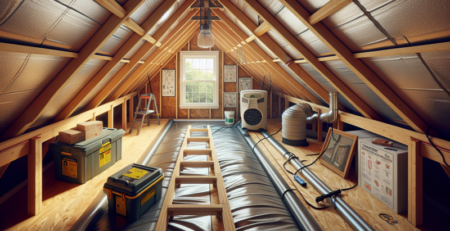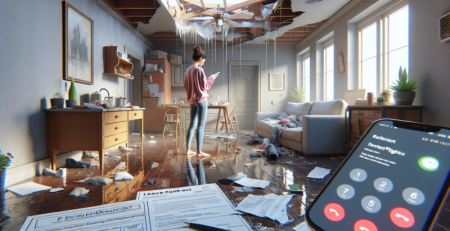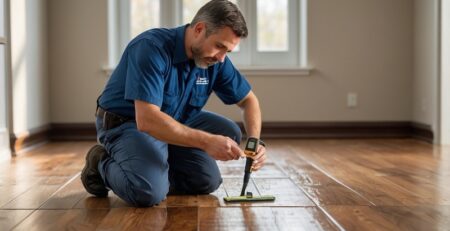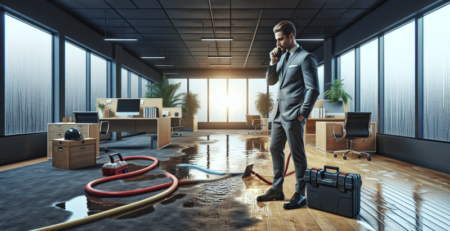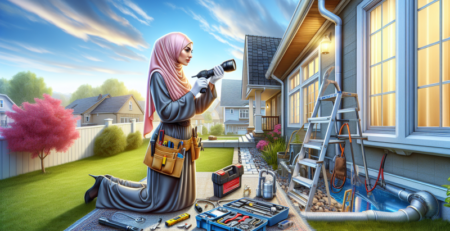Common Myths About Water Damage Restoration
Water damage restoration is a critical service that many homeowners may need at some point, yet there are numerous myths surrounding the process that can lead to confusion and misinformation. At Kraus Restoration, NJ’s leaders in water, mold, and fire damage restoration, we understand the importance of debunking these misconceptions to help you make informed decisions. With our IICRC certified experts available 24/7 for emergency services, we are committed to providing rapid response and effective solutions for water damage issues in Central and Northern NJ. In this blog, we will explore some of the most common myths about water damage restoration, clarify the facts, and guide you on how to properly address water-related problems in your home. If you ever find yourself in need of assistance, don’t hesitate to call us at (973) 886-2021 for expert help.
Understanding Water Damage: What You Need to Know
Water damage is a pervasive issue that can affect homes and businesses alike, leading to significant structural damage and health risks if not addressed promptly and effectively. Understanding the nature of water damage is crucial for property owners, as it can help dispel common myths surrounding water damage restoration and promote informed decision-making. Water damage can occur from various sources, including natural disasters, plumbing failures, and appliance malfunctions. According to the Federal Emergency Management Agency (FEMA), water damage is one of the most common and costly disasters faced by homeowners, with an estimated 14,000 people in the U.S. experiencing a water damage emergency each day.
One of the key aspects of understanding water damage is recognizing the different categories it can fall into. The Institute of Inspection, Cleaning and Restoration Certification (IICRC) classifies water damage into three categories: clean water, gray water, and black water. Clean water comes from a clean source, such as a broken pipe, while gray water contains some contaminants, like water from a washing machine. Black water is highly contaminated and can pose serious health risks, often resulting from sewage backups or flooding. Each category requires a different approach to restoration, emphasizing the importance of professional assessment and intervention.
Another critical factor to consider is the timeline for addressing water damage. The longer water sits, the more damage it can cause. According to the IICRC, mold can begin to grow within 24 to 48 hours after water exposure, making it essential to act quickly. This urgency is often misunderstood, leading to the myth that minor water damage can be left unattended for a while without consequences. In reality, even small leaks can lead to significant problems if not addressed promptly.
Moreover, many people believe that they can handle water damage restoration on their own. While some minor issues may be manageable, professional restoration services are often necessary for comprehensive cleanup and repair. Professionals have the training, equipment, and expertise to effectively remove water, dry out affected areas, and prevent mold growth. They also understand the complexities of water damage and can identify hidden issues that may not be immediately visible. Engaging a professional service, such as those offered by Kraus Restoration, ensures that the restoration process is thorough and effective.
It is also important to understand the long-term implications of water damage. Beyond immediate structural concerns, water damage can lead to health issues due to mold growth and compromised air quality. The World Health Organization (WHO) states that dampness and mold can cause respiratory problems and other health issues, particularly in vulnerable populations. This highlights the importance of not only addressing visible water damage but also ensuring that the environment is safe and healthy for occupants.
In terms of prevention, regular maintenance and inspections can significantly reduce the risk of water damage. Homeowners should routinely check for leaks, ensure proper drainage around their property, and maintain their plumbing systems. Additionally, investing in water detection systems can provide early warnings of leaks, allowing for prompt action before significant damage occurs.
In conclusion, understanding water damage is essential for effective prevention and restoration. By recognizing the different categories of water damage, the importance of timely intervention, and the benefits of professional restoration services, property owners can make informed decisions that protect their investments and ensure a safe living environment. For more information on how to protect your property from water damage, visit Kraus Restoration or explore our services to learn more about our comprehensive restoration solutions. Remember, when it comes to water damage, acting quickly and seeking professional help can save you time, money, and stress in the long run.
For further reading on water damage and restoration, consider checking out resources from the IICRC and FEMA, which provide valuable insights and guidelines for homeowners facing water-related issues.
Myth 1: All Water Damage is the Same
One of the most prevalent misconceptions about water damage is the belief that all water damage is the same. This myth can lead to significant misunderstandings regarding the necessary restoration processes and the urgency of addressing different types of water damage. In reality, water damage can be categorized into three distinct categories: clean water, gray water, and black water, each requiring different approaches for effective restoration.
Clean water damage originates from a clean source, such as a burst pipe or a malfunctioning appliance. While this type of damage is generally less hazardous, it still requires prompt attention to prevent further complications, such as mold growth. Restoration efforts for clean water damage typically involve water extraction, drying, and dehumidification. It is crucial to act quickly to mitigate any potential long-term effects.
Gray water damage, on the other hand, comes from sources that may contain contaminants, such as washing machine overflow or toilet overflow without feces. This type of water can pose health risks, and the restoration process must be more thorough. Professionals must not only remove the water but also sanitize the affected areas to eliminate any harmful bacteria or pathogens. Ignoring gray water damage can lead to serious health issues and extensive property damage.
Black water damage is the most severe category, originating from sources like sewage backups or floodwaters. This type of water is highly contaminated and poses significant health risks. Restoration of black water damage requires specialized equipment and techniques to ensure the safety of the occupants and the integrity of the property. It is essential to engage professional restoration services immediately when dealing with black water to minimize health risks and property loss.
Understanding the differences between these types of water damage is crucial for homeowners and business owners alike. Each category necessitates a tailored response to effectively restore the property and ensure the safety of its occupants. For instance, while clean water damage may allow for a quicker recovery, gray and black water damage require more extensive cleaning and restoration efforts. This is why it is vital to consult with professionals who specialize in water cleanup to assess the situation accurately and implement the appropriate restoration strategies.
Moreover, the misconception that all water damage is the same can lead to inadequate responses that exacerbate the situation. For example, treating gray water damage as if it were clean water can result in lingering contaminants that pose health risks. Similarly, failing to recognize the severity of black water damage can lead to dangerous living conditions. Therefore, it is essential to understand the specific type of water damage you are dealing with and to seek expert assistance.
In conclusion, not all water damage is created equal. Recognizing the differences between clean, gray, and black water damage is vital for effective restoration and ensuring the safety of your environment. If you experience any form of water damage, it is crucial to contact professionals who can provide the necessary expertise and services. For more information on how to handle water damage and to explore our comprehensive services, visit our website or reach out to us through our contact page. Understanding these distinctions will empower you to take the right steps in protecting your property and health.
Myth 2: DIY Solutions are Always Effective
When faced with water damage, many homeowners instinctively turn to DIY solutions, believing that they can effectively manage the situation without professional help. This common misconception can lead to significant problems down the line. While DIY methods may seem appealing due to their cost-effectiveness and the sense of control they provide, they often fall short in addressing the complexities of water damage restoration.
Water damage can stem from various sources, including flooding, leaks, or burst pipes, and each scenario presents unique challenges. DIY solutions typically involve superficial fixes, such as drying out the affected area or using household products to clean up. However, these methods often fail to tackle the underlying issues, such as hidden moisture, structural damage, or the potential for mold growth. Without proper assessment and remediation, what may seem like a minor issue can escalate into a much larger problem, resulting in costly repairs and health risks.
One of the primary reasons DIY solutions are not always effective is the lack of specialized knowledge and equipment. Professional water damage restoration services utilize advanced technology and techniques to thoroughly assess the damage, identify hidden moisture, and ensure complete drying. They have access to industrial-grade dehumidifiers, moisture meters, and infrared cameras, which are essential for detecting water that is not visible to the naked eye. In contrast, most homeowners do not possess these tools or the expertise to use them effectively, leading to incomplete restoration efforts.
Moreover, the risk of mold growth is a significant concern when dealing with water damage. Mold can begin to develop within 24 to 48 hours after water exposure, and once it takes hold, it can be challenging to eliminate. DIY methods often do not include the necessary steps for mold remediation, which requires specialized training and equipment. Professionals are trained to handle mold safely and effectively, ensuring that it is removed completely and that the environment is safe for occupants. Attempting to manage mold without proper knowledge can exacerbate the problem and pose serious health risks to those living in the affected area.
Another factor to consider is the potential for further damage during the DIY process. Homeowners may inadvertently cause more harm than good by using inappropriate cleaning methods or failing to address all affected areas. For example, using the wrong cleaning products can damage surfaces or materials, while inadequate drying can lead to structural issues, such as rotting wood or weakened foundations. Professional restoration services are equipped to handle these challenges, ensuring that the restoration process is thorough and minimizes the risk of additional damage.
In addition to the technical aspects, there is also a time factor to consider. Water damage restoration is a race against time. The longer water sits, the more damage it can cause. Professionals can respond quickly and efficiently, often providing same-day service to mitigate damage and begin the restoration process. In contrast, DIY solutions can lead to delays, allowing the situation to worsen and resulting in more extensive repairs.
Ultimately, while DIY solutions may seem like a viable option for addressing water damage, they often do not provide the comprehensive care needed to restore a property effectively. Homeowners should consider the long-term implications of their choices and the potential risks associated with inadequate restoration efforts. For those facing water damage, seeking professional assistance is the best course of action. Experts in water damage restoration can ensure that the job is done right the first time, protecting both the property and the health of its occupants. If you are dealing with water damage, do not hesitate to reach out to professionals who specialize in water cleanup and can provide the necessary expertise and resources to restore your home effectively. For more information about our services, visit our services page or contact us directly.
Myth 3: Mold Only Grows After Water Damage
One of the most pervasive myths surrounding mold growth is the belief that it only occurs after water damage has taken place. While it is true that water damage creates an ideal environment for mold to thrive, it is not the sole catalyst for mold growth. Mold spores are ubiquitous in our environment, existing in both indoor and outdoor settings. They are microscopic and can easily enter our homes through open doors, windows, or even on clothing and pets. Once inside, these spores can remain dormant until they encounter the right conditions for growth, which include moisture, warmth, and organic material to feed on.
Mold can begin to grow in areas with high humidity, even without any visible water damage. For instance, bathrooms, kitchens, and basements are common hotspots for mold due to their naturally higher moisture levels. Activities such as cooking, showering, or even drying clothes indoors can elevate humidity levels, creating a conducive environment for mold spores to settle and proliferate. Additionally, leaks from plumbing, condensation on windows, or even poorly ventilated spaces can lead to moisture accumulation, which can trigger mold growth without any significant water damage being evident.
It is also important to recognize that mold can develop in hidden areas, such as behind walls, under carpets, or in crawl spaces, where moisture may be present but not immediately visible. This means that even if a property appears dry on the surface, mold could still be lurking in areas that are not easily accessible or visible. Homeowners should be vigilant about maintaining proper ventilation and humidity levels throughout their homes to prevent mold growth, especially in areas prone to moisture.
Furthermore, mold can grow on a variety of surfaces, including wood, drywall, and even fabric, as long as there is sufficient moisture and organic material. This adaptability allows mold to thrive in various environments, making it crucial for homeowners to understand that mold prevention is not solely about addressing water damage. Regular inspections and maintenance are essential in identifying potential moisture issues before they lead to mold growth.
If you suspect mold in your home, it is vital to address the issue promptly. Professional mold cleanup services can help identify the source of moisture, remove the mold, and restore your home to a safe condition. For more information on how to effectively manage mold issues, you can explore our mold cleanup services.
In summary, while water damage is a significant factor that can lead to mold growth, it is not the only condition that fosters this problem. Mold spores are present in our environment and can thrive in various conditions, including high humidity and organic materials. Homeowners should take proactive measures to control moisture levels and conduct regular inspections to prevent mold growth, regardless of whether they have experienced water damage. For further assistance or to learn more about our comprehensive restoration services, feel free to contact us or visit our services page for more details.
Myth 4: Insurance Always Covers Water Damage Restoration
One of the most pervasive myths surrounding water damage restoration is the belief that insurance will always cover the costs associated with such incidents. While it is true that many homeowners have insurance policies that include coverage for water damage, the specifics of what is covered can vary significantly from one policy to another. Understanding the nuances of your insurance policy is crucial for homeowners to avoid unexpected financial burdens during a stressful time.
First and foremost, it is essential to differentiate between types of water damage. Most insurance policies typically cover sudden and accidental water damage, such as that caused by a burst pipe or an overflowing bathtub. However, damage resulting from long-term neglect or maintenance issues, such as a slow leak that has gone unnoticed for months, may not be covered. This distinction is critical because it means that homeowners must be vigilant about regular maintenance and inspections to prevent situations that could lead to uncovered damage.
Additionally, many policies have specific exclusions related to water damage. For example, damage caused by flooding is often not covered under standard homeowners insurance policies. Homeowners in flood-prone areas may need to purchase separate flood insurance to protect themselves from the financial repercussions of such events. This can lead to confusion and frustration when a homeowner assumes they are covered for all types of water damage, only to find out that their policy has limitations.
Another aspect to consider is the deductible associated with water damage claims. Even if a homeowner’s insurance policy does cover water damage, they may still be responsible for paying a deductible before the insurance kicks in. This means that in some cases, the out-of-pocket expenses for restoration can still be significant, especially if the damage is extensive. Homeowners should carefully review their policies to understand their deductibles and how they apply to water damage claims.
Moreover, the claims process itself can be complicated and time-consuming. Insurance companies often require extensive documentation and evidence of the damage before they approve a claim. This can include photographs, receipts, and detailed descriptions of the incident. Homeowners may find themselves navigating a complex claims process while simultaneously dealing with the stress of water damage restoration. It is advisable to keep thorough records and communicate promptly with the insurance adjuster to facilitate a smoother claims experience.
In some cases, homeowners may find that their insurance company disputes the claim or offers a settlement that does not cover the full extent of the restoration costs. This can lead to further complications and financial strain. To mitigate these risks, homeowners should consider working with professional restoration services that are experienced in dealing with insurance claims. These professionals can provide detailed assessments and documentation that can support the claims process, ensuring that homeowners receive the coverage they are entitled to.
Ultimately, while insurance can provide valuable financial support during water damage restoration, it is not a blanket solution. Homeowners must take proactive steps to understand their policies, maintain their properties, and be prepared for the possibility that not all water damage will be covered. For those seeking assistance with water damage restoration, it is essential to consult with experts who can guide you through the process and help you navigate the complexities of insurance coverage. For more information about our services, visit water cleanup or contact us for personalized assistance.
Myth 5: Restoration is a Quick and Easy Process
One of the most pervasive misconceptions about water damage restoration is the belief that it is a quick and easy process. Many homeowners assume that once the water is removed, the job is done, but this could not be further from the truth. Water damage restoration is a complex procedure that involves several critical steps, each requiring time, expertise, and the right equipment.
The first step in the restoration process is assessing the extent of the damage. This involves a thorough inspection of the affected areas to determine how far the water has penetrated and what materials have been compromised. This assessment is crucial because it informs the restoration team about the necessary actions to take. Depending on the severity of the water damage, this initial evaluation can take time, especially in larger properties or those with hidden water damage.
Once the assessment is complete, the next step is water extraction. This is where specialized equipment, such as industrial-grade pumps and vacuums, is used to remove standing water. While it may seem straightforward, this process can be labor-intensive and time-consuming, particularly in cases of severe flooding. After the bulk of the water is removed, the drying process begins. This is where high-powered fans and dehumidifiers come into play. Proper drying is essential to prevent mold growth and further structural damage, and it can take several days to ensure that all moisture is eliminated from the affected areas.
Another critical aspect of water damage restoration is cleaning and sanitizing the affected materials. Water can carry contaminants, and it is vital to ensure that any materials that have come into contact with the water are properly cleaned and disinfected. This step is particularly important in cases of sewage backup or flooding from contaminated sources. The cleaning process can be extensive and may involve the removal and replacement of certain materials, such as drywall or carpeting, which adds to the overall time required for restoration.
Furthermore, the restoration process often includes repairs and reconstruction. After the affected areas have been dried and cleaned, any damaged structures must be repaired or replaced. This could involve anything from patching walls to replacing flooring or even more extensive renovations. Each of these tasks requires skilled labor and can significantly extend the timeline of the restoration project.
It is also important to note that the timeline for restoration can vary greatly depending on the specific circumstances of each case. Factors such as the type of water involved, the extent of the damage, and the size of the affected area all play a role in determining how long the restoration process will take. For instance, a small leak may be resolved in a matter of days, while extensive flooding could take weeks or even months to fully restore.
In addition to the physical aspects of restoration, there is also the emotional toll that water damage can take on homeowners. The stress of dealing with the aftermath of water damage, coupled with the disruption to daily life, can make the process feel even longer. It is essential for homeowners to have realistic expectations and to understand that restoration is not just about removing water; it is about returning a home to its pre-damage condition, which requires time and careful attention to detail.
In conclusion, the notion that water damage restoration is a quick and easy process is a myth that can lead to misunderstandings and frustration. The reality is that restoration involves a series of detailed steps that require time, expertise, and the right equipment. Homeowners facing water damage should seek professional help to ensure that the restoration is done correctly and thoroughly. For more information on our comprehensive water cleanup services, or to learn about our company, feel free to reach out. Understanding the complexities of the restoration process can help homeowners navigate this challenging situation with greater clarity and confidence.
The Importance of Professional Assessment and Restoration
Water damage can be a homeowner’s worst nightmare, leading to significant structural issues and health risks if not addressed promptly and effectively. One of the most common myths surrounding water damage restoration is that homeowners can handle the cleanup and repairs on their own without professional help. While it may seem feasible to tackle minor water issues independently, the reality is that professional assessment and restoration are crucial for several reasons.
First and foremost, water damage can often be deceptive. What appears to be a small leak or minor flooding can lead to extensive hidden damage within walls, floors, and ceilings. Professionals trained in water damage restoration possess the expertise to identify these hidden issues. They utilize advanced tools and techniques to assess the full extent of the damage, ensuring that no area is overlooked. This thorough assessment is vital for preventing future problems, such as mold growth or structural instability, which can arise from inadequate cleanup.
Moreover, the restoration process requires specialized knowledge and equipment that the average homeowner may not possess. Professionals in the field are equipped with industrial-grade dehumidifiers, water extractors, and moisture detection devices that are essential for effective water removal and drying. These tools allow for a more efficient and thorough restoration process, significantly reducing the risk of secondary damage. Attempting to manage water damage without these resources can lead to prolonged exposure to moisture, creating an environment conducive to mold and mildew growth.
Another critical aspect of professional restoration is the health risks associated with water damage. Contaminated water, often referred to as black water, can pose serious health hazards. This type of water may contain harmful bacteria, viruses, and other pathogens that can lead to illness. Professionals are trained to handle hazardous materials safely and can ensure that the affected areas are sanitized and restored to a safe condition. Their expertise in dealing with various types of water damage, including those caused by sewage backups or flooding, is invaluable in protecting the health of your family and pets.
In addition to health concerns, the financial implications of water damage restoration cannot be overlooked. While it may seem cost-effective to attempt a DIY approach, the potential for additional damage and the need for more extensive repairs can lead to higher costs in the long run. Professional restoration services often work with insurance companies, helping homeowners navigate the claims process and ensuring that they receive the coverage they are entitled to. This support can alleviate the financial burden and provide peace of mind during a stressful time.
Furthermore, the speed of response is crucial when dealing with water damage. The longer water sits, the more damage it can cause. Professionals are trained to respond quickly, often within hours of a reported incident. Their prompt action can significantly reduce the extent of the damage and the associated costs. This rapid response is essential in mitigating the effects of water damage and restoring your home to its pre-damage condition.
Lastly, the restoration process does not end with water removal. Professionals provide comprehensive services that include drying, dehumidification, and repairs. They can also assist with any necessary renovations, ensuring that your home is not only restored but improved. This holistic approach to restoration can enhance the overall value and safety of your property.
In conclusion, the importance of professional assessment and restoration in the context of water damage cannot be overstated. The expertise, specialized equipment, and rapid response provided by professionals are essential for effectively addressing water damage and preventing further complications. Homeowners should recognize the value of enlisting professional help to ensure a thorough and safe restoration process. For more information on how to protect your home from water damage, visit our water cleanup services or learn about our mold cleanup services. If you have any questions or need assistance, feel free to contact us today.
In conclusion, understanding the common myths surrounding water damage restoration is crucial for homeowners and property managers alike. By debunking these misconceptions, we empower ourselves to make informed decisions when faced with water-related issues. It’s essential to recognize that professional restoration is not just about drying out the affected areas; it involves a comprehensive approach to ensure safety, prevent mold growth, and restore your property to its pre-damage condition.
By relying on facts rather than myths, you can better protect your home and investment. If you ever find yourself dealing with water damage, remember to consult with certified professionals who can provide the expertise and resources necessary for effective restoration. Staying informed and proactive will not only save you time and money but also help maintain the integrity of your living space. Don’t let myths lead you astray—equip yourself with knowledge and take the right steps towards recovery.
